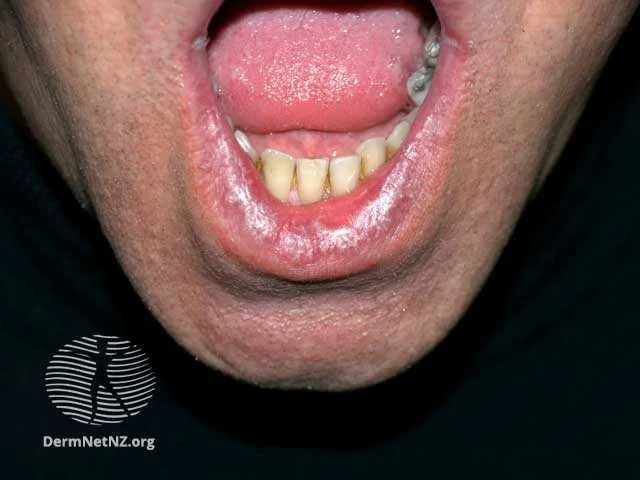
Lichen Planus
An example of lichen planus. The classic description of this rash is “purple, pruritic, polygonal papules”. Also, note the lacy white patches on top of the lesions.
Credit: DermNet NZ
What is lichen planus?
Lichen planus (LP) is a persistent inflammatory condition affecting the skin and mucosal surfaces. It manifests as violet, flat-topped lesions or plaques with a delicate white scale. While it can appear anywhere, common areas include the backs of hands, insides of wrists and arms, torso, fronts of legs, and the oral cavity. Importantly, lichen planus is not a contagious condition.
What causes lichen planus?
At its core, lichen planus is an autoimmune disorder where T cells target an unidentified protein in the skin and mucous membranes. While the exact cause remains elusive, an allergic reaction might occasionally trigger this immune response. Several factors potentially contributing to lichen planus include:
Genetic factors
Physical and emotional stressors
Skin trauma, such as post-surgical occurrences
Presence of localized skin conditions like herpes zoster
Systemic viral infections, notably hepatitis C
Contact allergies, for instance, reactions to metal dental fillings
What are the symptoms of lichen planus?
Lichen planus primarily presents as purplish, pruritic, flat-topped lesions or patches with characteristic white, lacy lines. These lesions can be isolated or clustered, varying in size from minute points to a few centimeters across. Though itching is the most common symptom, it's not universal; some individuals experience pain or no discomfort at all. While lichen planus can develop anywhere, it frequently appears on the wrists' front, lower back, and ankles. The condition might also manifest on the oral mucosa, nails, and genitals, with variations in appearance. Other possible characteristics include:
Glossy or scaly skin presentation
Yellow-brown discoloration, especially on palms or soles
Residual greyish-brown skin patches post lesion resolution
Occasionally, lesions with an un-thickened center
In rare instances, blisters
How do I treat Lichen Planus?
The need for treatment hinges on the severity of the condition. Without intervention, skin lesions typically fade in 6–9 months, though oral lesions might persist longer. Potential treatment options encompass:
Potent topical corticosteroids
Non-steroidal topical agents like tacrolimus and pimecrolimus
Direct steroid injections into affected sites
Anesthetic oral rinses, such as those with lidocaine (for oral lesions)
Systemic steroids, such as prednisone (for extensive disease)
Oral immunosuppressants, including cyclosporine, acitretin, hydroxychloroquine, or methotrexate (for widespread or refractory disease)
Oral lichen planus can affect the lips, gums and inner cheeks.
Credit: DermNet NZ
Lichen planus can cause severe nail abnormalities and nail scarring.
Credit: DermNet NZ



